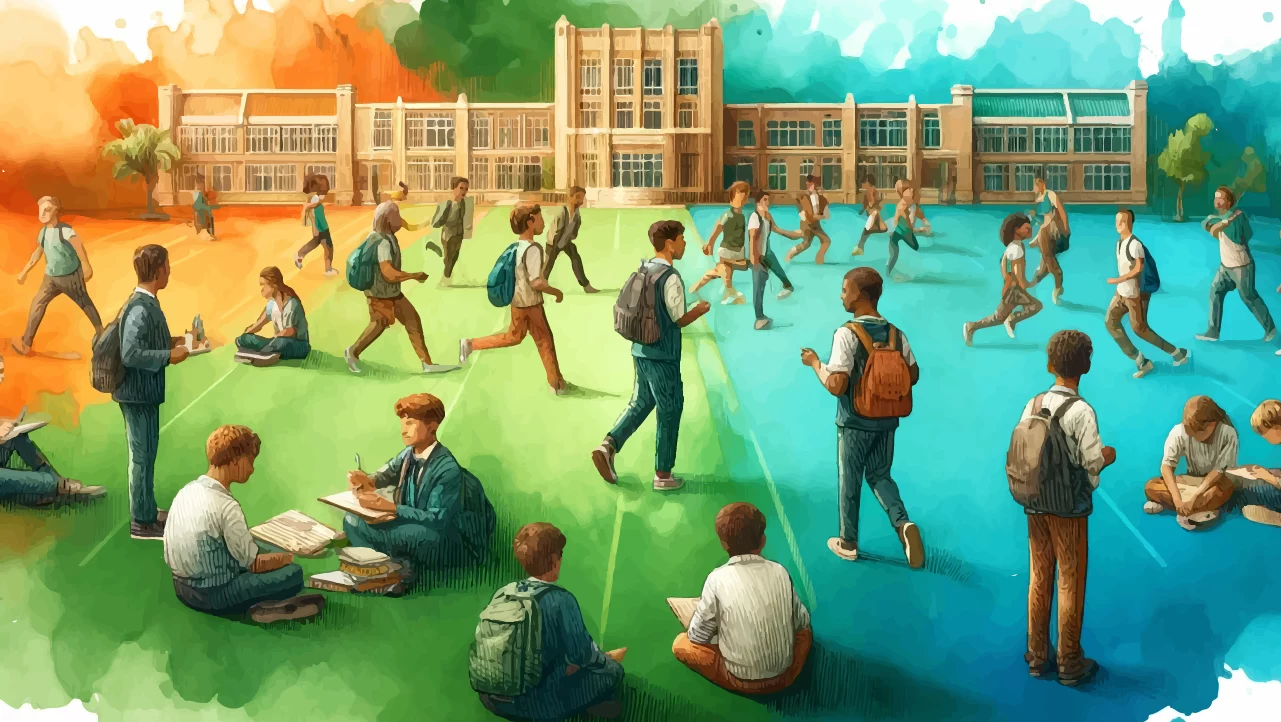ResearchEducation & Skills
Degrees of Difference: Male College Enrollment and Completion

Summary:
Over the last several decades, multiple gender gaps have emerged in college enrollment and graduation rates across institution and degree types. In 2021, men received 42% of bachelor’s degrees awarded in the United States, the lowest male share on record and approximately equal to the 43% of bachelor’s degrees awarded to women in 1970. Women are 11 percentage points more likely to graduate from a four-year institution in four years and 7 percentage points more likely to graduate within six years. These disparities persist across racial groups and are highest for Black and Hispanic students. Though the trends are not new, the continued growth of these disparities pose significant questions for administrators, policymakers, and students.
Key Takeaways:
- There are now 2.4 million more female than male undergraduates on U.S. campuses (8.9 million women compared to 6.5 million men), a gap that is largely driven by stagnating male enrollment in 4-year colleges.
- In 2022, women were 9 percentage points more likely to be enrolled in college in the fall following high school graduation, a gap that has steadily widened in recent decades
- Men are also less likely to complete college than women: the four-year graduation rate at four-year institutions, for example, is 54% for female students compared to 43% for male students.
- There are gender gaps in enrollment and graduation across all major racial groups, but the gender gaps are generally wider for Black and Hispanic men.
Over the last half-century, the share of postsecondary degrees being awarded to men has declined. As Figure 1 shows, the percentage of Bachelor’s degrees conferred to men in 2021 was 42%, down from 57% in 1970. There have been even steeper declines at other degree levels.
Figure 1
The male share could be lower because men are less likely to enroll in college, or because they are less likely to finish college after enrolling, or both. Here we examine trends in both enrollment and completion. We show that the male share of students enrolling in college has declined dramatically, and that male completion rates are persistently lower. Combined, these two gender gaps—in both enrollment and completion—cause the lower male share of degrees awarded. These patterns hold across racial groups and most institution types.
This descriptive analysis underscores the need for further research to understand the key factors driving the decline in male higher education attainment—and, crucially, to identify effective strategies for reversing this trend.
Immediate Enrollment Rates
Many students enroll in college straight from high school. But there is a gender gap in rates of immediate enrollment as Figure 2 shows.
Figure 2
In 2022, 57% of male high school graduates enrolled in college, compared to 66% of their female counterparts. While the percent of women immediately in college has seen a steady increase, only recently stabilizing, the percent of men enrolling in college has been more stagnant. The rate of immediate college enrollment for men is the same in 2022 as it was in 1964. Rates also fell sharply in 2021, resulting in the widest gender gap in immediate enrollment since 1968—favoring women rather than men—at 14.6 percentage points.
Overall Enrollment Rates
Of course not all college students enroll directly from high school. It could be that men enroll at a similar rate, just a few years later. But they do not: overall enrollment rates are still much lower for men. Figure 3 shows the share of men and women aged 18-24 who are enrolled in college, for the whole population and for the four largest racial and ethnic categories.
Figure 3
There are wide race gaps in college enrollment, but young men are less likely to be in college than young women in every racial group. The size of the gap does vary, however. Notably, Hispanic men lag behind Hispanic women by 12 percentage points. In contrast, Asian students have both high rates of enrollment and the smallest gender gap, with men trailing women by only 6 percentage points.
Gender Gaps on Campus
Given these trends in college enrollment rates, it is not surprising that there are many more women than men on campuses. In 2021, men accounted for 42% of total undergraduate enrollment. The male share is slightly higher among full-time students at 44% and slightly lower among part-time students at 40%. Mirroring the trend for degree conferral, the gender gap in college enrollment first emerged in the 1980s and has widened steadily since. Figure 4 shows the absolute number of male and female students enrolled in 4-year and 2-year institutions.
Figure 4
In 2021, there were 2.4 million fewer men than women pursuing undergraduate degrees, with approximately 8.9 million women compared to 6.5 million men. There are about as many men on college campuses now as there were 15 years ago. As shown in Figure 4, the gender gap is largely the result of stagnating male enrollment at 4-year institutions: enrollment at 2-year institutions is on the decline for both men and women, while the enrollment of women at 4-year institutions continues to rise. In contrast, the numbers for men have leveled off, suggesting a concerning trend: women appear to be shifting up, while men appear to be shifting out.
College Completion
Men not only enter college at lower rates, but they are also are less likely to complete their course of study. It might be expected that with fewer male students, those who do attend are more likely to succeed due to selection effects. But that is not borne out by the data: the gender graduation gap has been consistent for the last 20 years, across all standard time-to-graduation metrics, and is evident in nearly all types of higher education institutions.
Figure 5 shows the “on time” graduation rates for men and women at four-year and two-year institutions since the entering class of 1996.
Figure 5
While completion rates for both genders have increased substantially over the last 20 years, the gap between male and female completion has been relatively steady. At four-year institutions, there was a 7 percentage-point gap in six-year completion rates for the cohort entering in 2016 (61% for men versus 68% for women), compared to a 6 percentage-point gap for the 1996 cohort (52% for men versus 58% for women).
A closer look at completion rates shows that if men do complete college, they are less likely than women to do so quickly. Figure 6 shows 4-year and 6-year completion rates at 4-year institutions. The gender gap in four-year graduation rates is 11 percentage points, narrowing to 7 percentage points for six-year rates. Since men take longer to complete college (if they do complete), this means that the overall enrollment numbers may paint a somewhat distorted picture, since they capture men who, if they had graduated earlier, wouldn’t be enrolled).
For both genders, completion rates are the highest at private non-profit institutions, followed by public institutions, and trailed far behind by private for-profits. But the size of the gap is similar across institute types. Private for-profits are an exception to the rule – this is the only subsample of the data we examined where outcomes are better for men than women.
Figure 6
Just as with enrollment, the gender gap in completion rates can be seen across racial groups, albeit with distinct patterns. The largest disparities here are observed among Black students. Black women are 12 percentage points more likely to graduate within six years than Black men. However, it’s important to note that the completion rates of Black women are still lower than those of men from all other racial groups. In other words, the race gaps are wider than the gender gaps. Interestingly, Hispanic students, who have the lowest enrollment rates, exhibit relatively higher completion rates, hinting at potential selection effects. Overall, these nuanced patterns suggest that a gender and race sensitive approach to designing and targeting interventions is needed.
Figure 7
Conclusion
The relative underperformance of men in higher education is a significant challenge for the sector. Men benefit, just as women do, from a college degree, and postsecondary education remains an important potential route to upward mobility. This does not mean, of course, that alternatives to college are not worthy of equal attention, especially given that they may be more suitable for many young men (see our work on apprenticeships, for example).
There is also much more work to do to understand the different patterns of male higher education achievement. This includes exploring the decline in the share of men pursuing “HEAL” (health, education, administration and literacy) majors and achievement across different kinds of institutions of higher education, including community colleges, regional public universities, public flagships, liberal arts colleges and graduate schools.
The trends described in this brief demand urgent attention from policymakers and from higher education institutions themselves. But right now, we don’t have a good understanding of what the best strategies to reverse these trends would be.
If you work on efforts to recruit and retain more men in higher education, please get in touch. And stay updated on our ongoing research and other work related to men in higher education by subscribing to our newsletter.
Thank you to Ravan Hawrami for research assistance.
Subscribe to our Newsletter
Get the latest developments on the trends and issues facing boys and men.
Related Research

Education & Skills
Research Summary: Three ideas to help boys at school
In this research summary, Richard V. Reeves proposes three distinct policy approaches to address gender gaps in education, ranging from gender-neutral to gender-based policies, advocating for interventions aimed at creating a more male-friendly K-12 education system.

Education & Skills
Missing Misters: Gender Diversity among Teachers
Learn about the male teacher shortage in U.S. schools, its impact on boys' education, and why it should be a policy priority.

Education & Skills
Where Are the Men? Male Representation in Social Work and Psychology
Men face a significant lack of representation in mental health professions despite the growing mental health needs among them.